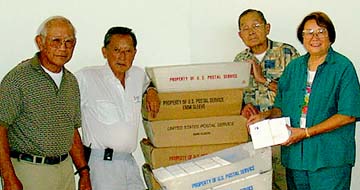


|
CD-ROM to On April 5, 1945, 19 Japanese Americans, members of the 100th Battalion/442nd Regimental Combat Team from Hawaii, were killed as the segregated Army unit began its last major battle of World War II.
honor the heroic
WWII nisei
The soldiers defeated the Germans
in a vital diversionary assaultBy Gregg K. Kakesako
gkakesako@starbulletin.comIn 24 days of fighting, the Po Valley campaign claimed the lives of 102 members of the 100th/442nd.
The legacy of the 19 men of 100th/442nd is the focus of the AJA WWII Memorial Alliance's "Echoes of Silence" CD-ROM educational project due out later this year. The CD-ROM lists in alphabetical order the 812 nisei (second-generation Japanese Americans) from Hawaii and their Caucasian officers, who died in World War II. Of the total, 510 were nisei from Hawaii -- 119 were from the Big Island, 53 from Kauai, 95 from Maui and 243 from Oahu.
The project was initiated by a group of mainland nisei veterans drawn together in 1997 to develop a memorial in Los Angeles. That memorial was dedicated on Feb. 19, 2000, in Los Angeles' Little Tokyo district.
The World War II memorial includes the names of 779 Americans of Japanese ancestry and 30 Caucasian officers who served beside them. Also included are the names of 15 men and one officer who served with the 100th/442nd Regimental Combat Team who later died in the Korean War. Recipients of the Medal of Honor, bestowed posthumously, are also identified.
Jim Yamashita, CD-ROM project manager for the AJA WWII Memorial Alliance's educational project in Los Angeles, said besides listing the personal histories of the 812 soldiers, the CD-ROM also will contain the history of the 100th Battalion, the 442nd Regimental Combat Team, the Military Intelligence Service and the 1399th Construction Battalion and other units in which niseis served during World War II.
"Assembling the biographies of those on the mainland has been a challenge because of the difficulties in locating families of KIAs (killed in action)," Yamashita said.
Yamashita said the 100th/442nd "had just taken on new replacements after being decimated in rescuing the 'Lost Battalion.' That is why many of the KIAs (killed in action) near the war's end were strangers in their own platoon, the reason why many of the originals don't recognize the names because they themselves had already left the company due to prior injuries. If it were not for the projects such as ours, these replacements and their families will be forgotten victims of the much heralded unit."
The 100th/442nd had been called to Italy by Gen. Mark Clark for a vital secret mission -- spearheading a diversionary assault on the western sector of the Gothic Line. The 100th/442nd returned to Italy in April 1945 to breach the German Gothic Line, which had blocked the Allied advance for six months. The 100th/442nd broke through the German defenses in less than a day and in the next three weeks forced the German army to retreat north to the Po Valley, where it finally surrendered on May 2, 1945.
For nine months, the Germans had built formidable fortifications in the Apennines mountain range. Drilled out of solid rock and reinforced concrete, the Germans had placed machine gun nests, gun emplacements, rifle pits and trenches from the coastal area to the mountains of Carrachio and Altissimo. More than 2,300 machine gun nests were positioned to produce interlocking fire along the Gothic Line. Observation posts provided an unparalleled view of the valleys -- any movement by an American in the valley would result in a rain of German mortars. Despite continual bombing, strafing and artillery fire by the Allies, the line seemed impregnable.
The task of scaling the 3,000-foot saddle between Mount Cerreta and Mount Fologorita in the dark with full combat gear was given to the 100th Battalion.
At dawn on April 5, 1945, elements of the 100th Battalion, supported by artillery fire from the 442nd Regimental Combat Team batteries, began a frontal attack on one of the mountains while other soldiers who had spent the night scaling the 3,000-foot mountain moved in from the top.
The unit's first Medal of Honor recipient -- Pvt. 1st Class Sadao Muneo -- died when he smothered the blast of a German hand grenade with his body, saving the lives of two of his men.

AJA WWII Memorial seeks input
The AJA WWII Memorial Alliance is seeking help from friends and relatives of niseis and the Caucasian officers who died while serving with them in World War II. Anyone with such information or who is interested in helping with the distribution of the CD-ROM can contact: AJA WWII Memorial Alliance; P.O. Box 1945; Montebello, CA 90640 or e-mail jimy@adelphia.net.